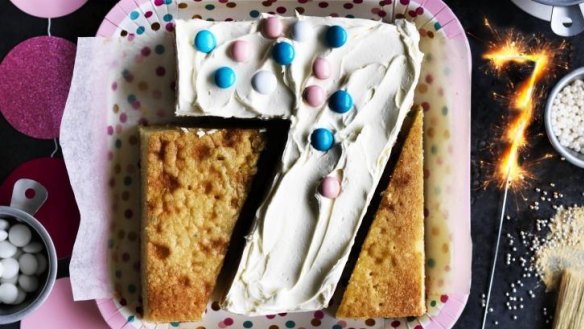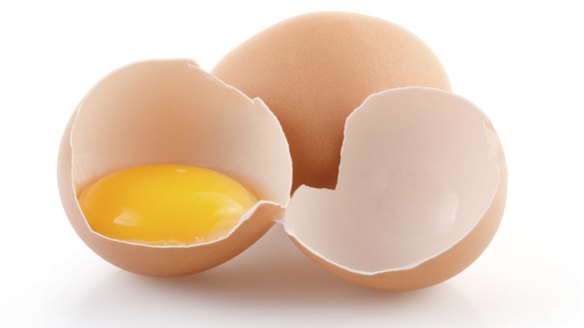Solve your cake emergency: baking tips and fixes

- Recipe: Dan Lepard's basic butter cake
- Recipe: Gluten-free chocolate birthday cake
- Video: How to build a pinata cake
- Best kid's birthday cake competition: send us a photo
"I have had so many baking disasters," admits master baker Nadine Ingram, owner of Sydney's Flour and Stone.
She recalls the time when she tried to simultaneously make 30 cakes from three different recipes (lesson: use different mixing bowls so you can tell them apart) and another when she failed to follow a brief for a 40th birthday cake. "The recipient was so shocked when she opened the door that her immediate reaction was to refuse to let me in," she says.
Since then, Ingram has gained experience and broadened her baking repertoire, which includes Flour and Stone's famed lemon dream cake, layered with meringue, lemon curd and double cream. But when it comes to baking at home, creating a hit recipe isn't the focus – it's getting someone else's right. And getting it right can be critical when parenthood's demands turn out to include producing bangin' baked goods for the kinder cake stall, allergen-free cupcakes for the under-14 netball team, or a Star Wars-themed birthday spectacular for your budding Jedi.
This list of baking tips and fixes from the pros will help you get the most out of your oven, ingredients and even your disasters.
Avoid and conquer
Always try to avoid baking fails before they happen. Ingram suggests reading the recipe and making sure you have all the ingredients before you start. The biggest key to baking success, she says, is using your gut. "The most common mistake people make when baking is following the cooking time stated in the recipe, rather than using intuition to test when it's ready. Everyone's oven is different, so whatever time it gives for readiness, cut 10 minutes off and check it then – chances are it's already cooked."
Raising havoc
We've all been there: the land of sunken sponges. If your cake hasn't risen, it's probably because the correct chemical raising ingredient wasn't added, the batter was over-mixed (or under-whipped in the case of eggs) or the pan was too large. Phillippa Grogan, the baker and businesswoman behind Phillippa's bakery, calls sagging cakes a "disaster" and thinks they're better off "crumbed and added to a little creamed butter, icing sugar, cocoa and rum-soaked raisins and turned into rum balls rolled in coconut or cocoa."
Award-winning celebrity baker and Good Food columnist Dan Lepard suggests thinking outside the tin when met with deflated dough. "Why not cut it horizontally into two thin sheets, line a small mixing bowl with some ClingWrap, press one part of the cake into it, fill the middle with buttercream or mousse and then put the other bit back on top to make a cake bombe?"

Honey, I destroyed the cake
Surprisingly, dealing with a burnt cake is far easier. If your cake looks as though it flew too close to the sun, Lepard suggests slicing off the top, side and edges with a sharp bread knife and covering the entire thing in chocolate icing. If it's dry, as burnt cakes often are, melt 50 grams of sugar in 50 millilitres of water with a tablespoon of vanilla extract, orange zest or booze to make a sugar syrup, then brush it over the cake before the icing stage.
In a rush
Many cakes become more moist if you freeze and then thaw them, making it possible to prebake a cake if you know you're going to be short on time. Alternatively Lepard suggests adding a tablespoon of really good cocoa and 50 grams of chocolate to a packet cake mix to lift the flavour – although ask Ingram if packet cakes are ever OK and her stance is clear. "No, absolutely not!" she says. "It doesn't take any more time to make a cake from scratch than to use a packet mix, you just need to have the ingredients. My 13-year old daughter gets home from school in the afternoon and she can have a cake in the oven within half an hour."
Icing explainer
Teacher-turned Instabaking sensation Katherine Sabbath is renowned for her layer cakes dripping with neon and crowned with upside-down ice cream cones. With nearly 300,000 Instagram followers and a new ambassadorial role for Pyrex (her mixing jugs are more than 20 years old), she knows a thing or two about icing. Her favourite frostings are Swiss and Italian meringue buttercream, which are light, velvety and great vessels for carrying flavour. Sabbath saves glazes for adding a glossy shine, recommends fondant for decorating and making cake toppers (you can also cover your cake in fondant to make it last longer) and ganache for something rich and silky.
Mile-high cakes
There's also a trick to making the perfect layer cakes – those towering beauties that are currently trending. Sabbath chills her cakes before slicing them into layers, which apparently reduces both crumbs and tears. She also suggests adding a cold dollop of your filling or icing of choice to secure the cake to the serving tray. "This will make sure it stays in one place and keep the bottom layer extra moist," she says, "double win!"
The importance of ingredients
The ingredients you use are as important as the method. As a rule of thumb, Grogan suggests buying the best you can afford, being sure to pay extra attention to good eggs – she reckons free-range, pasture-fed chook eggs add superior flavour and colour to a cake. "The flavour of the end result of a cake entirely depends on the quality of the ingredients," she says.

Gluten-free substitutes
There are dietary requests and there are dietary requirements, but everyone has a right to eat gluten and dairy-free food. Adi Kerr is the production manager at Little Bertha, whose gluten-free baked goods you've almost definitely eaten at a Melbourne cafe. "Cakes can be delicious without gluten and they can be delicious without eggs," says Kerr. He explains that gluten is the carbohydrate behind the structure of a cake, so if you don't include gluten, you need some other starch to keep it intact – Little Bertha uses a combination of maize starch, rice flour, tapioca starch and rice bran.
Sugar and colouring alternatives
Natural sweeteners like coconut sugar or agave syrup are great sugar alternatives and readily available at supermarkets as well as specialty grocers. As for colour, steer clear of scary supermarket dyes and turn to pistachio powder for a green tinge, or freeze-dried fruit powders for pinks, reds, oranges and yellows. "We have to go back to natural dying using things from the earth," says Kerr, "but people definitely buy with their eyes so the more colourful you can make it, the better."
For kids
Kerry Vincent – known for baking, writing and judging Food Network Challenge and the Great Australian Bake Off – acknowledges that parents can get carried away with cakes for their kids, causing unnecessary stress in the process. "When children are young they want involvement, and no matter what you might create for them, it'll never top the pride they feel when they've been involved from the start," she says. Her suggestions? Give kids plain cupcakes or cookies and let them decorate their own with small plastic piping bags of coloured icing and their favourite sweets. Alternatively, replace Play-Doh with rolled fondant and ask them to make cake topper figurines and animals.
The best recipes from Australia's leading chefs straight to your inbox.
Sign up